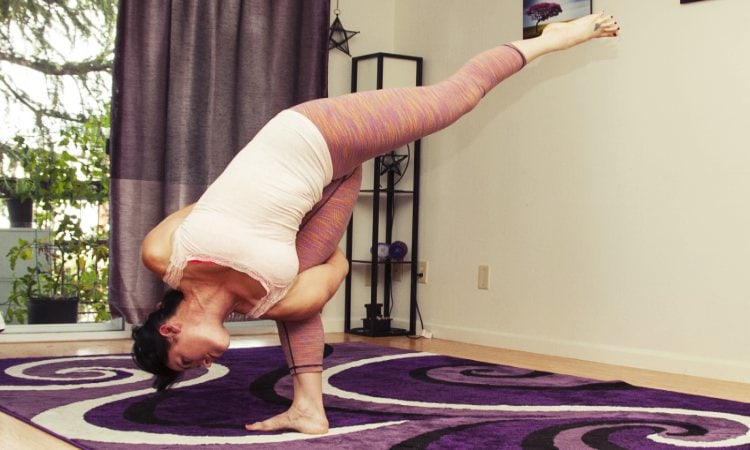"Jump, and you will find out how to unfold your wings as you fall." ~Ray Bradbury
In my decade of teaching, I have learned that while everybody can do yoga not everybody has the same relationship to falling.
I have observed three distinct types of reactions a yoga practitioner can have when initially confronted by a challenging pose such as an arm balance or inversion.
Three Types of Yogis
The first yogi might notice a desire to look for the nearest exit, use the cell phone, or have a sudden urge to go to the bathroom. Fear arises quickly, overpowers the mind, and in some cases paralyzes the body. This can linger for years—making some poses off limits because they instigate so much anxiety.
Student number two will prepare for the pose by learning the technique, intellectualizing the form, and spending time understanding his or her physical limitations. However, somehow, this student struggles for a long time—not quite finding the "oomph" for lift-off.
The third yogi is fearless. They exert large amounts of power, landing on their back or head, or breaking the fall on a shoulder or forearm. While I’ve never seen any immediate injury from these instances, I have observed chronic pain show up in students from repeatedly landing in less than optimal ways.
The Fear of Falling
I am a combination of student one and two after spending five years avoiding any asana that required me to balance on my head or hands.
I avoided and procrastinated, fighting the process until I finally realized that all of my excuses boiled down to one thing: the fear of falling.
I committed to practicing these intimidating poses with dedication by weaving the following movements into the yoga sequences for both my public classes and my own home yoga routine.
Creating a safe scenario where you can practice intentionally "falling," you will gradually transform a healthy fear into the courage needed to safely execute asanas that require a great deal of balance.
1. Trust: Backwards Motion
Incorporating stepping or jumping backwards on your mat encourages trust. You cannot see where your feet will land, so you have to invite other ways of “knowing” into your yoga.
The expanded spatial awareness that you develop by moving in patterns atypical from your daily routine (i.e walking forward) trains you to invite possibility and embrace the unexpected into your practice.
In addition to strengthening underused muscle groups and increasing your ability to stabilize during balancing challenges, you will learn how move into the unknown and feel your way through the moment.
- From Tadasana or Mountain Pose, step back into Anjaneyasana or Crescent Pose.
- Jump backwards to Chaturanga Dandasana or Four-Limbed Staff Pose from Standing.
2. Focus: Standing on Tip Toes
This pose creates an unstable surface for the legs, while a steady gaze on a point of stillness helps maintain a physical steadiness during a rather wobbly situation.
Begin in Tadasana by rising up on the toes, which strengthens the foot and ankles, and then find your center by stacking the shoulders over the hips. Essentially this movement simulates a less scary, "right side-up" handstand.
You will find that engaging the arms and abdominals while breathing (do not hold the breath here) helps to keep you grounded.
Rather than attempting to force the body still, try to move in the directions that you teeter. Balance does not mean holding a pose in a statue-like "stuck" position, but instead opening up to the many fluctuations within those calm moments. Go with the flow!
For an extra challenge, try doing this on one foot.
3. Release Expectations: Cartwheels
Similarly to backwards motions, the lateral movements in a cartwheel also deviate from the "norm" and train the body in multiple planes of motion.
Always try your cartwheel from both sides—the lesson in this movement exists in the awkwardness of leading with your non-dominant side. Please do not set your mind on perfection. You will develop the balance between the right and left side of the body over time. Be playful!
Warning: you might experience a fit of the giggles while attempting this.
In yoga, as in life, sometimes you experience balance between stillness and motion, and sometimes you will fall. You have the innate fight, flight, or freeze response to any fear that arises, and you also have the power of choice!
Practice observing your natural reactions in these unstable moments, when the floor beneath you seems shaky and when you feel confronted by something new and unfamiliar.
Breathe, focus, and remember that deep within your core—not your abs, but the essence of your being—lay balance, stability, and peace. Now, go find it!
Image credit / Yogi: Judy Rukat


